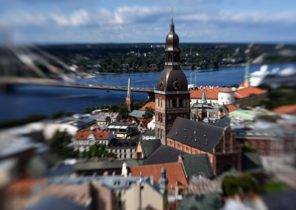
Many observers in the West predicted the collapse of the Russian economy when oil prices three years ago, began to fall. Too strong it seemed the country’s dependence on “black gold”. Turned out differently: flexible exchange rate had the Russian economy needed support, and the situation has improved again. That is all well in the Empire of Vladimir Putin?
Not really. Because as soon as it begins to seem that everything comes back to normal, there is another problem, which previously did not get in sight for the banking crisis. Although the head of the Central Bank of Russia Elvira Nabiullina since 2013 firmly directs the weakening financial institutions that do not meet the required standards and are guided by questionable business practices. 340 of them it has already unceremoniously closed. While it was almost exclusively on small banks.
But now the case takes a serious turn for the first time we had a big player — Bank “Ugra”. Among the remaining 600 banks, he enters into the 30 largest banks by total assets and the top 20 largest deposits. In addition, negative news appeared about the leader of branch — the savings Bank. The Bank is struggling to return billion loan from Croatia.
In the case of the Bank “Ugra” we are talking about the largest bankruptcy in recent years. In addition, it is the largest insurance event in Russian financial history. Six months, the Bank transferred the management of the Agency for Deposit insurance, accounts of the depositors of yet frozen. The Central Bank and Agency on insurance of deposits should pay the deposits of the Bank in the amount of 170 billion rubles (2.5 billion euros), said the Deputy Chairman of the Central Bank Vasily Pozdyshev.
The bankruptcy was preceded by a long struggle
Mapping reveals the full scale of the bankruptcy of the Bank “Ugra”: first largest insured event — bankruptcy “Master-Bank” — at a cost of 35 billion rubles. It’s a disaster for the Agency, it has for the last 3.5 years, during which it was paid a total of 1.1 trillion rubles to depositors of the liquidated banks were in a difficult situation and needed help from the Central Bank.
According to experts, the Central Bank this time will be forced to run the printing press to solve the problem. Payments to depositors will begin in two weeks. Every investor claims to insurance benefits in the amount in the range of 1.4 million rubles.
The bankruptcy was not unexpected. In the second half of may, the Central Bank decided that the Bank “Ugra”, you need to create additional reserves in the amount of 40 billion rubles. This decree was preceded by a long struggle with the controller.
So, the Bank in April last year, was allowed only a limited acceptance of deposits from physical persons. However, the Bank partially worked around this restriction, making the investors “shareholders” quoted insiders to the newspaper “Vedomosti”.
In addition, in recent years there were signs that provide information about the assets of the Bank were inaccurate, said Pozdyshev.
Selling larger Bank without liquidation
The Bank “Ugra” is present on the market for 27 years. For many years he did not show much success. In 2012 in ranking in terms of assets among Russian banks it was at 272. However, then began a dizzying rise, and in 2015 he joined the list of the 35 largest banks.
The question of ownership has also become transparent with time. For many years the owners were twelve individuals, while the real beneficiaries were hiding, which again caused discontent on the part of the Central Bank. Only in January 2016, it became clear that the financial Institute belongs to the Moscow businessmen in real estate to Yuri and Alexei Hominem. Most of the shares belonged to the Swiss company Radamant Financial AG.
“At the moment the situation is unclear, because the Bank was in compliance with all regulations of the Central Bank and fully liquid,” says Alexei Nefedov, President of the Bank “Ugra”.
The Supervisory authority sees the situation differently. There are suspicions that the owners replenish the core capital of the Bank with loans from other banks, and that half of the loans given to the companies affiliated with the Bank.
Whether the Bank under the reorganization transferred to another Bank or liquidated, it will become clear over the next months.
Both Russia’s largest Bank are losing money
Trouble is, and the leader in the banking industry, Sberbank — although not as dramatic. The Institute is waiting for the return billion loan from Croatia, which in April went bankrupt, the largest retail concern Agrokor and was taken under state control. Sberbank is the largest lender of the company: he received a loan in the amount of 1.1 billion euros.
Agrokor in Croatia is considered to be a company of systemic importance. The group provides 60 thousand jobs in retail chains Konzum and Mercator, 40 thousand of them in Croatia and about 10 thousand in Slovenia and Serbia. If we add the related sectors and logistics, from the fate of Agrokor depend on tens of thousands of jobs.
The government has allocated for the rehabilitation of 15 months. Agrokor debts are estimated at 5.4 billion euros, including 800 million euros of the liabilities of Slovenian Mercator shopping daughters.
In addition to Sberbank, the loan Agrokor issued and the second largest Russian Bank VTB — 30 million euros. What are the reserves established VTB for their share of the unknown.
The Central Bank plays into the hands of Sberbank
That is a total of a quarter of loans Agrokor is therefore, as they say, the Kremlin is dissatisfied with the risky maneuver of Sberbank. The head of the Bank Herman Gref, in turn, expressed indignation at the fact that Croatia with situational law retroactively limited the rights of creditors.
However, the bankruptcy of Croatian companies did not halt the rise of the savings Bank after several years of recession in the country. In June the profit amounted to 55 billion rubles, which is 22.2% higher than last year. Profit in the first half of this year amounted to 317 billion rubles by 38.2% higher than last year.
As the reason for a further upswing given the decline in interest on deposits and the growing trend for loans to private individuals. The Russian Central Bank in June lowered its key interest rate three times this year to 9%. With the closure of small banks he also played into the hands of large financial institutions. First of all, the savings Bank, whose main shareholder he [CB] is.







